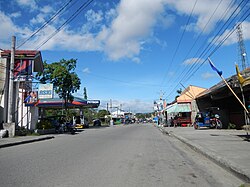This article needs additional citations for verification .(October 2013) |
Rizal | |
|---|---|
| Municipality of Rizal | |
 Downtown | |
 Map of Nueva Ecija with Rizal highlighted | |
Location within the Philippines | |
| Coordinates: 15°42′36″N121°06′17″E / 15.71°N 121.1047°E | |
| Country | Philippines |
| Region | Central Luzon |
| Province | Nueva Ecija |
| District | 2nd district |
| Founded | 1913 |
| Named after | Dr. José Rizal |
| Barangays | 26 (see Barangays) |
| Government | |
| • Type | Sangguniang Bayan |
| • Mayor | Hanna Katrina L. Andres |
| • Vice Mayor | Rafaelito V. Andres |
| • Representative | Mario O. Salvador |
| • Municipal Council | Members |
| • Electorate | 37,002 voters (2025) |
| Area | |
• Total | 120.55 km2 (46.54 sq mi) |
| Elevation | 103 m (338 ft) |
| Highest elevation | 327 m (1,073 ft) |
| Lowest elevation | 71 m (233 ft) |
| Population (2024 census) [3] | |
• Total | 71,749 |
| • Density | 600/km2 (1,500/sq mi) |
| • Households | 17,402 |
| Economy | |
| • Income class | 2nd municipal income class |
| • Poverty incidence | 13.98 |
| • Revenue | ₱ 299.6 million (2022) |
| • Assets | ₱ 771.8 million (2022) |
| • Expenditure | ₱ 245.2 million (2022) |
| • Liabilities | ₱ 238.9 million (2022) |
| Service provider | |
| • Electricity | Nueva Ecija 2 Area 2 Electric Cooperative (NEECO 2 A2) |
| Time zone | UTC+8 (PST) |
| ZIP code | 3127 |
| PSGC | |
| IDD : area code | +63 (0)44 |
| Native languages | Ilocano Tagalog |
Rizal, officially the Municipality of Rizal (Ilocano : Ili ti Rizal; Tagalog : Bayan ng Rizal) is a municipality in the province of Nueva Ecija, Philippines. According to the 2020 census, it has a population of 70,196 people. [5]




